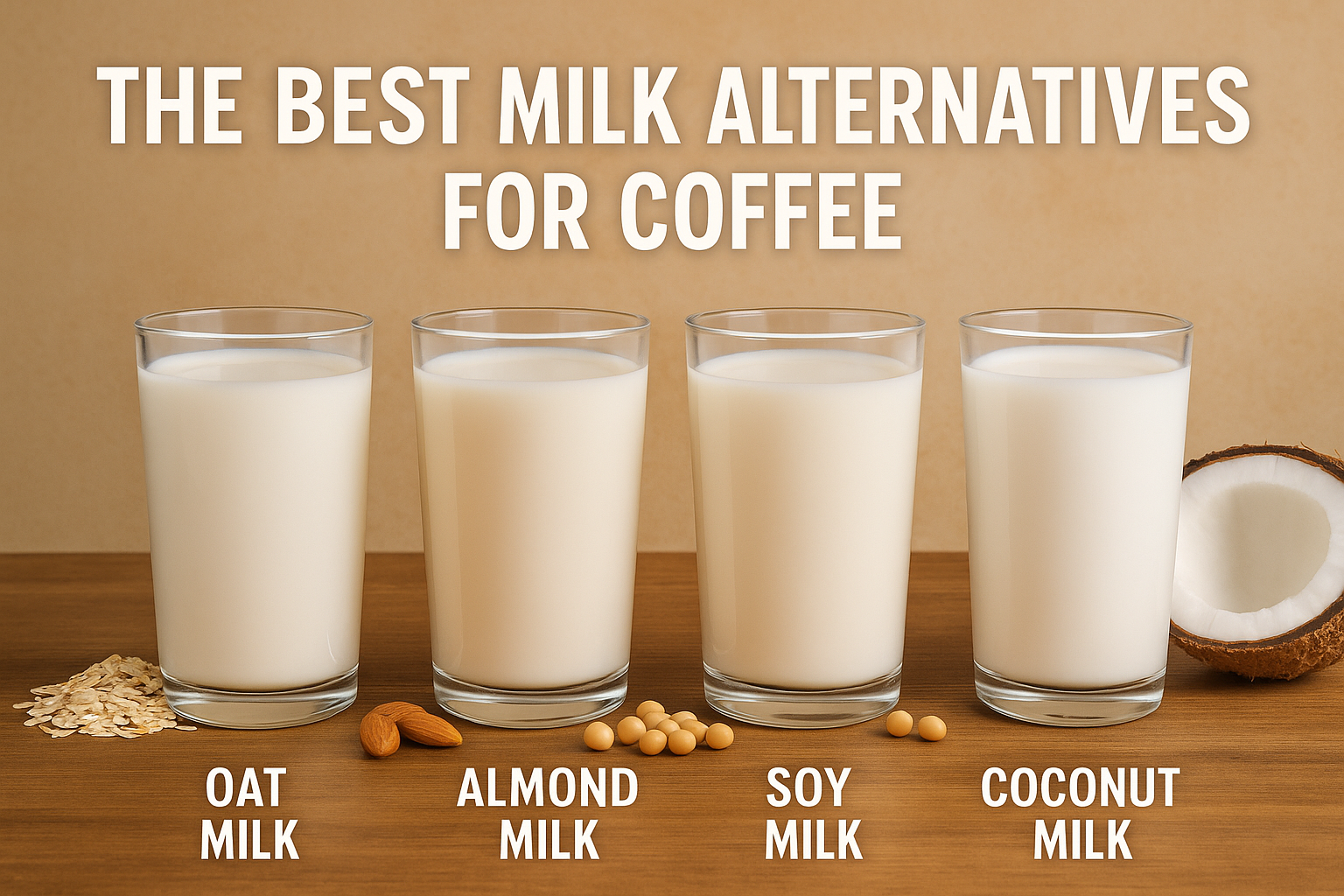For coffee lovers who avoid dairy—whether due to lactose intolerance, dietary preference, or ethical reasons—plant-based milk alternatives have become a staple. But not all non-dairy milks behave the same when paired with coffee.
Some curdle in hot espresso, others overpower the flavor, and a few simply refuse to froth. So which are the best milk alternatives for coffee? This comprehensive guide compares taste, texture, and frothing ability of the most popular options, so you can choose the one that suits your brew and lifestyle.
Why Choosing the Right Plant-Based Milk Matters
The milk you add to your coffee affects:
- Flavor – it should complement, not dominate the coffee.
- Texture – especially important in lattes and cappuccinos.
- Temperature stability – some milks curdle when heated or mixed with acidic espresso.
- Frothing – critical for milk-based drinks like lattes, flat whites, and cortados.
Not all plant milks are created equal, and different brands can vary widely. Still, some options consistently perform better than others in the coffee world.
1. Oat Milk
Taste: Slightly sweet, creamy, and neutral—great for enhancing coffee without overpowering it.
Texture: Smooth and rich, closely mimics whole milk.
Frothing: Excellent. Oat milk froths very well and holds its foam, especially barista editions.
Pros:
- Balanced flavor
- Great microfoam for latte art
- Popular in specialty cafés
Cons:
- Can be more expensive
- Some brands contain oils and stabilizers
Best For: Lattes, cappuccinos, and flat whites.
2. Almond Milk
Taste: Nutty and slightly bitter, can compete with the coffee’s natural flavors.
Texture: Thin unless fortified or thickened. Some versions feel watery.
Frothing: Difficult to froth unless labeled as “barista blend.” Prone to separating or curdling.
Pros:
- Low-calorie option
- Widely available
- Pairs well with flavored coffee
Cons:
- Often separates in hot coffee
- Weak foam structure
Best For: Iced coffee, smoothies, or drip coffee with a splash.
3. Soy Milk
Taste: Mild and beany, sometimes sweet depending on the brand.
Texture: Thicker than almond milk, similar to 2% dairy milk.
Frothing: Froths well with some training. Barista blends perform significantly better.
Pros:
- High protein content
- Creates smooth foam
- Affordable and common
Cons:
- May curdle with acidic coffee
- Slight aftertaste
Best For: Hot drinks like lattes and macchiatos.
4. Coconut Milk
Taste: Strong coconut flavor that can dominate the coffee.
Texture: Creamy, sometimes oily depending on the fat content.
Frothing: Froths poorly unless mixed with other plant milks. Can produce large bubbles but lacks microfoam.
Pros:
- Rich and indulgent
- Good in cold brews and tropical-inspired drinks
Cons:
- Not neutral—will change coffee’s flavor
- Poor stability when heated
Best For: Iced lattes, dessert-style drinks, and smoothies.
5. Cashew Milk
Taste: Mild, creamy, and subtly nutty.
Texture: Thick and smooth, similar to whole milk.
Frothing: Froths okay, but doesn’t hold shape long. Works better cold than hot.
Pros:
- Creamy feel without strong flavor
- Blends well with espresso
Cons:
- Harder to find than almond or oat
- Inconsistent frothing
Best For: Cold coffee drinks, espresso blends.
6. Rice Milk
Taste: Sweet and watery, with a light cereal-like flavor.
Texture: Very thin and not creamy.
Frothing: Minimal froth, separates easily.
Pros:
- Hypoallergenic
- Naturally sweet
Cons:
- Watery texture
- Not suitable for lattes or cappuccinos
Best For: Drip coffee or iced coffee with a splash of milk.
7. Pea Protein Milk (e.g., Ripple)
Taste: Neutral and mild, doesn’t overpower coffee.
Texture: Creamy and similar to dairy milk.
Frothing: Froths well—especially in barista blends.
Pros:
- High protein content
- Stable in hot drinks
- Low allergen risk
Cons:
- Limited availability
- Some versions can taste chalky
Best For: Steamed drinks, protein-rich coffee beverages.
Frothing Performance Comparison
| Milk Type | Frothing (1–5) | Latte Art Potential | Stability in Hot Drinks |
|---|---|---|---|
| Oat Milk | 5 | Excellent | Very Stable |
| Almond Milk | 2 | Poor | Low |
| Soy Milk | 4 | Good | Medium-Stable |
| Coconut Milk | 2 | Poor | Low |
| Cashew Milk | 3 | Medium | Medium |
| Rice Milk | 1 | Very Poor | Unstable |
| Pea Milk | 4 | Good | High |
Best Milk Alternatives for Specific Coffee Drinks
- Latte: Oat or soy milk
- Cappuccino: Oat milk
- Flat White: Oat or pea milk
- Cold Brew: Almond or coconut milk
- Espresso Macchiato: Pea or soy milk (minimal curdling)
- Iced Coffee: Almond, rice, or coconut (depending on flavor preference)
Tips for Better Results with Plant-Based Milk
- Use Barista Blends: These are formulated to resist curdling and foam better.
- Don’t Overheat: Keep milk under 60°C (140°F) to avoid curdling or burning.
- Steam in Short Bursts: For better microfoam and texture.
- Shake or Stir Before Pouring: Some milks settle and need mixing.
Final Thoughts: Find Your Perfect Pairing
Plant-based milks have come a long way—and so have your options. Whether you’re after rich foam, mild flavor, or a specific dietary benefit, there’s a milk alternative that fits your coffee routine. Try a few and see which brings out the best in your beans, whether you’re pulling espresso or sipping cold brew on a summer day.
With the right plant-based milk, you’ll never miss dairy again.

Marcelo Oliveira is a coffee enthusiast and content creator specializing in barista skills, brewing methods, equipment reviews, coffee-related health insights, and fascinating curiosities from the coffee world. With a deep passion for every step of the brewing process, he turns technical knowledge into accessible and engaging content for both beginners and seasoned coffee lovers. Marcelo’s goal is to help readers appreciate the full experience of coffee—from bean to cup.
